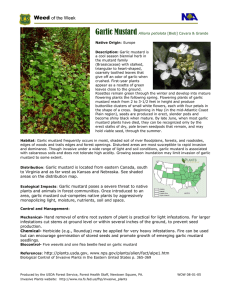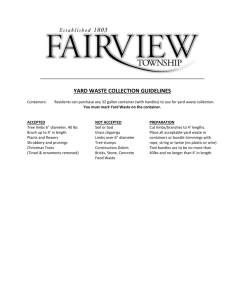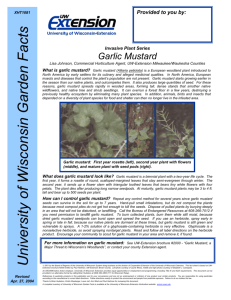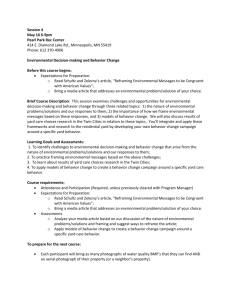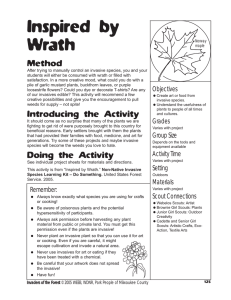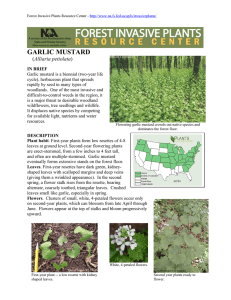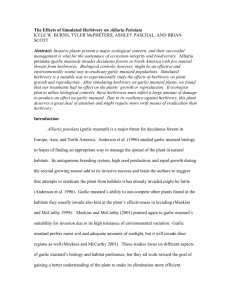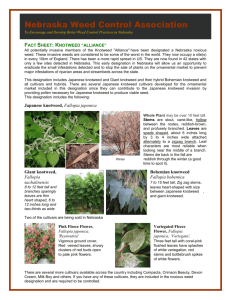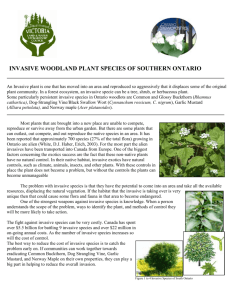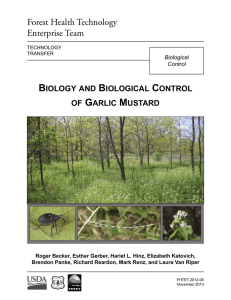Resource - The Stewardship Network
advertisement
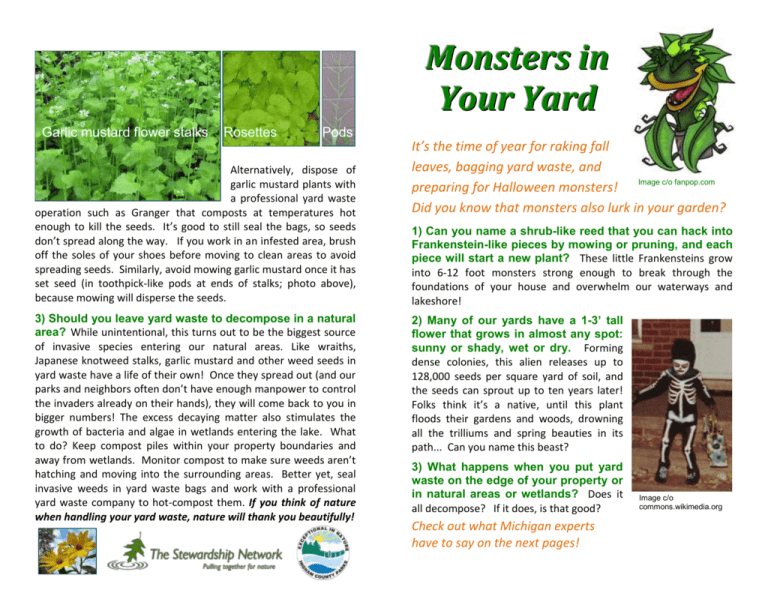
Monsters in Your Yard Garlic mustard flower stalks Rosettes Pods Alternatively, dispose of garlic mustard plants with a professional yard waste operation such as Granger that composts at temperatures hot enough to kill the seeds. It’s good to still seal the bags, so seeds don’t spread along the way. If you work in an infested area, brush off the soles of your shoes before moving to clean areas to avoid spreading seeds. Similarly, avoid mowing garlic mustard once it has set seed (in toothpick-like pods at ends of stalks; photo above), because mowing will disperse the seeds. 3) Should you leave yard waste to decompose in a natural area? While unintentional, this turns out to be the biggest source of invasive species entering our natural areas. Like wraiths, Japanese knotweed stalks, garlic mustard and other weed seeds in yard waste have a life of their own! Once they spread out (and our parks and neighbors often don’t have enough manpower to control the invaders already on their hands), they will come back to you in bigger numbers! The excess decaying matter also stimulates the growth of bacteria and algae in wetlands entering the lake. What to do? Keep compost piles within your property boundaries and away from wetlands. Monitor compost to make sure weeds aren’t hatching and moving into the surrounding areas. Better yet, seal invasive weeds in yard waste bags and work with a professional yard waste company to hot-compost them. If you think of nature when handling your yard waste, nature will thank you beautifully! It’s the time of year for raking fall leaves, bagging yard waste, and preparing for Halloween monsters! Image c/o fanpop.com Did you know that monsters also lurk in your garden? 1) Can you name a shrub-like reed that you can hack into Frankenstein-like pieces by mowing or pruning, and each piece will start a new plant? These little Frankensteins grow into 6-12 foot monsters strong enough to break through the foundations of your house and overwhelm our waterways and lakeshore! 2) Many of our yards have a 1-3’ tall flower that grows in almost any spot: sunny or shady, wet or dry. Forming dense colonies, this alien releases up to 128,000 seeds per square yard of soil, and the seeds can sprout up to ten years later! Folks think it’s a native, until this plant floods their gardens and woods, drowning all the trilliums and spring beauties in its path... Can you name this beast? 3) What happens when you put yard waste on the edge of your property or in natural areas or wetlands? Does it all decompose? If it does, is that good? Check out what Michigan experts have to say on the next pages! Image c/o commons.wikimedia.org Answer 1) Frankensteins. There are two invasive plants like this in our area! The plant that can grow from stalk or root fragments and break through cement is Japanese knotweed (photo below). It evolved to grow on lava, and was initially sold as an ornamental plant. This plant is now prohibited in Michigan due to the damage it causes to roads, buildings, and natural areas. Mowing or cutting Japanese knotweed only stimulates the spread of its massive roots. Fragments of the stems and roots dragged by the mower will start knotweed plants in new spots. Unfortunately, it is only controlled well by specialty herbicides that aren’t available over the counter. If you think you have Japanese knotweed on your land, send a close-up photo to KuhnL@msu.edu, and we’ll help! Mid-Michigan Stewardship and Ingham County Parks lead a regional Japanese knotweed control effort. the seeds, stems, and root cuttings carried by the mower can start new plants. For controlling Phragmites with herbicides, special precautions are needed near wetlands, which recharge our drinking water and are home to sensitive wildlife. If you see Phragmites on your land, send a photo to KuhnL@msu.edu at Mid-Michigan Stewardship), and we’ll help! Phragmites stalk Phragmites colony Japanese knotweed Phragmites (frag-might-ees, also called common reed; see photos on next page) is the second Frankenstein, originally planted to stabilize ditches before folks realized that it devours waterways, wetlands, and lakeshores. Phragmites is a giant, dense, reed-like grass, growing 8-12 feet tall with feathery seed heads, and a colony can spread up to 60 feet per year. It is considered a threat by MDNR, MDEQ, and MDOT, filling in habitat needed by wildlife, undermining roads, and presenting a fire hazard because it burns hot and fast. Its spread is also stimulated by mowing/cutting, since 2) Alien flowers in your garden. Garlic mustard (shown on the next page) is the highly invasive biennial. Imported from Europe to the East Coast as an herb, it had spread to Michigan by the 1950s. Garlic mustard leafs out early and has a longer growing season than our native wildflowers. It blooms in May-June and then seeds profusely in July. Mustard plants produce chemicals that make them distasteful to herbivores and insects and also taint the soil, preventing nitrogen fixation by native plants. Garlic mustard rosettes (late 1st year and early 2nd year plants) outside of wet areas can be sprayed with RoundUp™ (or equivalent) in the late fall or early spring (when temperatures are ≥45F). RoundUp™ shouldn’t be used in wet areas because it’s toxic to frogs, salamanders, and fish. Garlic mustard seeds are long-lasting and not killed by lowtemperature home composting. It’s best to tightly bag and dispose of flower or seed-bearing plants in your trash, which is buried in a landfill where the plants can’t grow. This is supported by invasive species regulations (Michigan Compiled Law, section 324.11521).




